Social coin in Spain
Tuesday, March 26, 2013
The “Social coin” is a way of exchange.It is there, when we talk about buy and sell.
The social coin is an alternative to the Economy that we know
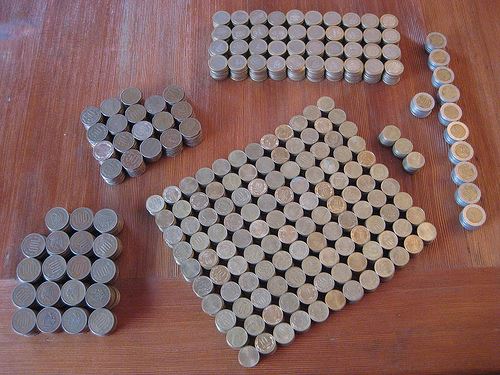
"monedas!", by (MGM), at flickr.com
There are several ways to show the social coin: for example with a paper, where we write the price of a thing or a service.
Another way is to write it in a computer.
Normally, it is used in a local area. For example in the district of London, Bristol. They are agree to use that coin as if it was a Pound.It shows that this system favors the local economy.
In Spain, there are several cases with this system.For example, in Villarreal (Castellon, East of Spain), they use a bond, that combines social currency with banks of time.So, you can combine hours of work, for other people or use the social coin.
Also, in the Palma island, there is a social currency, named “Drago”. They want to extend this coin to all the Canary Islands, in order to protect the economy in those islands. And so, they think they can create employment. Then, they have created the named “Drago Bank”. As it is a combination among social coin and Bank of Time, each person who entere in that system of computer, receive 5 hours and 2000 “Dragos”.

"Puesta de sol en La Palma", La Palma Island, Canarias Islands, South of Spain, by perlaroques, at flickr.com
Another village, in the Canarian Islands, La Isleta (Gran Canaria), has another similar system, created by the Assembly of the “15 M”, that use the social coin named “Demos”, in order that everyone who can not cover its needs, can do it with this system.
By another side, in Valencia (East of Spain), the Foundation “Red Sostenible y Creativa” launched in late 2010 the project "Suns".So is named the social coin that is already used in three neighborhoods of Valencia.With this system, many people is abble to be helped; for example, someone can live is a house, given thanks to the “Suns”.With this system, many people is connected among them.This system favors the “Pay it forward”.
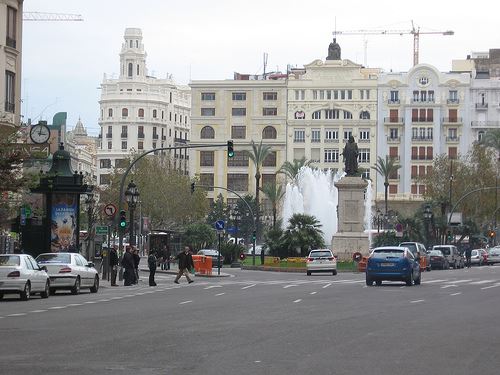
"valencia 193", Valencia, east of Spain, by ho visto nina volare, at flickr.com
It seems to be very interesting; is not it?.
Till soon, kind regards,
Luis.
Sponsored by Costaluz Lawyers.
Please click down here:
.jpg)
 0
Like
Published at 11:57 AM Comments (0)
0
Like
Published at 11:57 AM Comments (0)
Salobreña: An unique village in the coast of Andalusia
Monday, March 25, 2013
Salobreña is situated to the west of Motril, 75 kilometers from Granada and 505 kilometers from Madrid.
Spread out on a hill, its white streets and steep, winding route, they move up to the summit, crowned by the castle, which is one of the best preserved Arab fortresses in Andalusia.
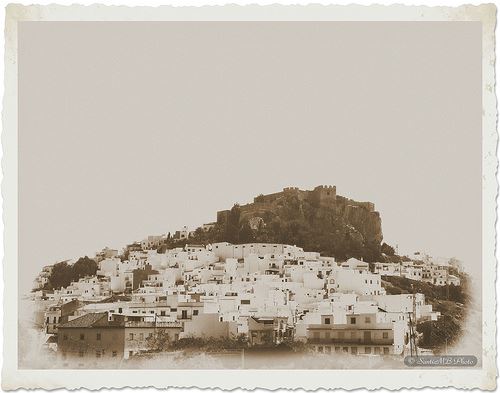
"Salobreña", Granada, South-east of Spain, by SantiMB, at flickr.com
In Salobreña, that now has ten thousand inhabitants, is the only cane sugar factory in Europe.
Salobreña, in Phoenician times, it was an important trading.
The Phoenicians also founded: Gadir (Cádiz), Malaka Sexi (Almuñecar, Granada) and Abdera (Adra, Almería).
Salobreña was very important, in arab time, thanks to the sugar cane. But, in the last years, it has developed thanks to tourism and the cultivation of tropical plants.
The three districts of Salobreña are: the Brocal, with its beautiful facades and streets.
The second one is: the Albayzin, next to the castle, from the observed good views from its nearly one hundred meters of altitude.
The third one is: La Fuente (the Source), with its white houses and patios full of flowers.
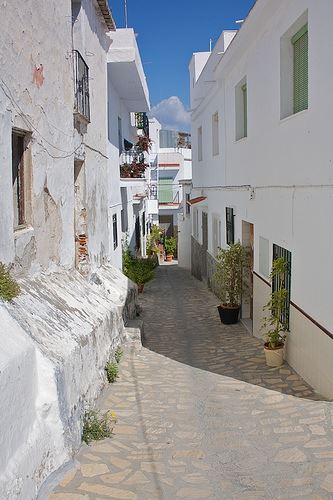
"Salobreña´s street", Salobreña, Granada, South-east of Spain, by Natalia Romay, at flickr.com
The Alcazaba: At the top of the Rock, the remains of this fortress, of Phoenician origin, built by Romans and Arabs, in Century XIII. From its height there is a nice view.
The church of Our Lady of the Rosary: it open only at 9:00 pm and 20:00 pm: on Sunday: at 10:00 pm, when it open for Mass.
Close the Alcazaba, this church is a Moorish work of the sixteenth century. The original cover was paneled, but fire in the nineteenth century.
The Rock, on the Promenade of Salobreña, from here, you can see some nice views.And here have been found Archaeological remains of Roman times.
The Factory of Sugar: it was built in the century XIX.Also you can visit a Musseum.
In Salobreña, there are three beaches: The Rock, La Charca (the pond) and La Guardia.
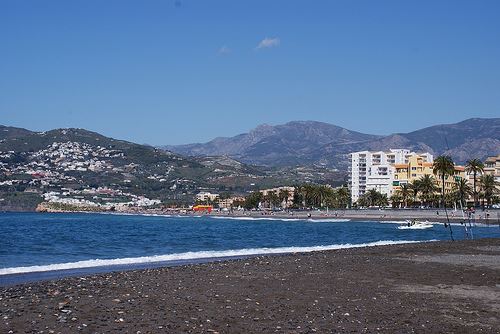
"Salobreña", Granada, South-east of Spain, by Phranet, at flickr.com
You can do two main excursions: to Almuñécar and to Motril.
If you go to Salobreña, you can stay at “Casa de los Bates”, on the road of Mirasierra, Motril.Telephone number: 958 34 94 95. www.casadelosbates.com.
Another place: “Cortijo de la luna”: Pago de Taramay, Loma del Gato, Almuñecar. Telephone number: 958 88 09 31. www.cortijoluna.com.
Restaurants:
Mesón Durán: National Road 340, kilometer 343. Telephone: 958 82 88 29. Meat and fhish, with easy cooked.
Playa Jacquy Cotobro: Building River Beach.. Walk Cotobro, without number, Almuñecar. Telephone: 958 63 1802. French cooking.
La Bodega de Salobreña: Avenue of Motril, without number. Telephone: 958 82 87 39. There are: sausages, meats, salats, gazpacho, soups, and, above all, a lot of fishes.
Tropical: Avenue Rodriguez Acosta, 23. Telephone: 958 60 04 50. Above all: fishes and shelifish.And the tipical dessert: the Morish Cake.
I hope that you can come to Salobreña very soon.
Kind regards,
Luis.
Sponsored by Costaluz Lawyers.
Please click down here:
.jpg)
 0
Like
Published at 12:00 PM Comments (1)
0
Like
Published at 12:00 PM Comments (1)
A Palace with history in Northern Spain
Friday, March 22, 2013
The Palace of Bendaña or Paternina has begun to be reformed in 2010. The nickname, Paternina, is due to the famous painter of La Rioja with that name.
The budget reform amounts to 3 million Euros.
Haro is a unique city because of the amount of ancient cellars which houses.But, aldos, this city has a great historical and artistic heritage; between other significant buildings is the Palace Bendaña.
Located in the old medieval wall is a great example of Plateresque of decorative profusion. The building has three floors and is built in stone with special emphasis on its two facades (a sixteenth century and one of the eighteenth century) and the gallery s.XV Mudejar intertwined with stars and flowers, only in La Rioja.
As an important element of the architecture found in access, padded jambs, floral and angels in the segments of the lintel.

Palace Bendaña, Haro (La Rioja, North-east of Spain)
The rehabilitation of this Palace has been overseen by the Architects Alfonso Samaniego and Carlos Madrigal.
The Ministry of Development, Ana Pastor, has just opened the Palace, after rehabilitation. This new building will house the Tourist Office and the Municipal Library. But it also be used as a Musseum and in the Palaceshall be celebrate a Governing Council by the Regional Government. And, of course, it shall be opened for all people, every visitor.
As you can see, on the side of the building there are holes through which light enters inside, givin the building a special uniqueness.
.jpg)
Holes on a side of the facade The building is constructed of stone, wood and glass.
I hope this rehabilitation allows to Haro to be visited by many people.
Till soon, kind regards,
Luis.
Sponsored by Costaluz Lawyers.
Please click down here:
.jpg)
 0
Like
Published at 11:08 AM Comments (0)
0
Like
Published at 11:08 AM Comments (0)
The SAMPA in Spain
Monday, March 18, 2013
The SAMPA is a System Autonomous of Motorization, Forecasting and Warning, used to predict sea conditions.
The Minister Ana Pastor has presented at Algeciras and visited the Port Control Tower.

Ana Pastor in the Control tower of the Port of Algeciras
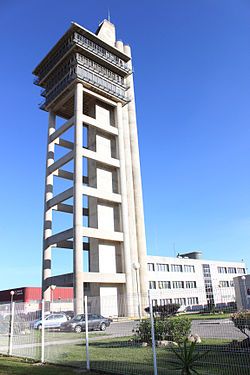
The Control Tower
This system develops a mobile application that can be used by any user, in a free way and under Android or iPhone.
The new Autonomous System Motorization, Forecasting and Warning (Sampa), developed from initial form to the Strait of Gibraltar through the Port Authority of the Bay of Algeciras (Cádiz, South of Spain), will provide a complete description of the real-time sea conditions.
This device, presented at Algeciras by the Minister of Development, Ana Pastor, is "a before and after in technology" tied to the weather forecast, given its "reliability" because it has "the most advanced measures" to predict phenomena such as waves or currents.
The system consists of three main modules, the first permanent measurement, equipped with oceanographic buoys, sea level stations, weather stations and current meters, whose function is to provide a complete description of the real-time sea conditions.
The second one is a prediction system based on the hydrodynamic modeling in 3D of a given sea area, which allows to know in advance variables such as waves, wind, sea level and currents.
The last module is a set of tools among which a specific display generation and other email alerts and sms based on automatic detection of adverse situations.
The system also including a mobile application development, called IMAR, which allows operations activities taking place in the access port to data dike foot.
The Minister of Development and Transport has highlighted the importance of the port of Algeciras, which has been elected to the pilot, because the Strait of Gibraltar is one of the most important shipping areas in the world, with an annual traffic of 100.000 ships.
Ana Pastor said that the objective of the project is now "that is in all the port authorities of the State Ports" and extends to the "international collaboration for implementation in other countries in our region”.
The minister has welcomed the fact that "Spain is a leader in the development of technologies in the world" and has "the best educated generation."
I think this project is a breakthrough for our communications and externally.
Till soon, kind regards,
Luis.
Sponsored by Costaluz Lawyers.
Please click down here:
.jpg)
 0
Like
Published at 4:05 PM Comments (0)
0
Like
Published at 4:05 PM Comments (0)
Friendly cities in Spain
Saturday, March 16, 2013
The World Network Friendly Cities with Older People aims to promote active aging by optimizing participation, improved health conditions and increased security environments in order to improve the quality of life of the elderly.
These are the Friendly cities in Spain:
Zaragoza (Aragón), Santander (Cantabria), Barcelona / Manresa and Vic (Cataluña), Liria (Valencia), Almendralejo / Mata de Alcántara / Mérida and Oliva de la Frontera (Extremadura), Bilbao / San Sebastián and Vitoria (Euskadi), Orense (Galice), Tres Cantos and Las Rozas (Madrid).
Friendly Cities Program with Older People is an international project to help cities prepare for two global demographic trends: the rapid aging of the population and increasing urbanization. The program is aimed at environmental, social and economic factors that influence health and well-being of older people.
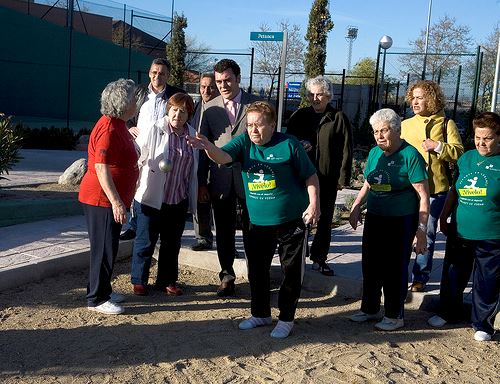
"Jugando a la petanca en Fortuna", Fortuna, Murcia, East of Spain, by Rafael Gomez Montoya, at flickr.com
In 2006, the World Health Organization brought together 33 cities in 22 countries on a project to identify the main elements of the urban environment that facilitate healthy aging. The result was the publication Global cities age-friendly: A Guide in establishing the framework for assessing adaptation of cities to the needs of the elderly. Central to the process was to have the active participation of those people.
The guide identifies eight domains of city life that can affect the health and quality of life of older people:
Outdoor spaces and buildings.
Transport.
Housing.
Social participation.
Respect and social integration.
Civic participation and employment.
Communication and information, and
Community support and health services.
To take advantage of the great interest generated by this program, WHO has created the Global Friendly Cities Older Persons, that:
It shall establish relations between participating cities and among them and the WHO.
It shall facilitate the exchange of information and best practices.
It shall encourage appropriate interventions, sustainable and cost effective to improve the lives of older people.
It shall provide technical support and training.
I think that seems to be a very interesting project, that I did not know, till today.I like older people, because they have a great experience of Live, for teaching us, younger people.Therefore, I think that they deserve much respect.
Till soon, kind regards,
Luis.
Sponsored by Costaluz Lawyers.
Please click down here:
.jpg)
 0
Like
Published at 8:58 PM Comments (0)
0
Like
Published at 8:58 PM Comments (0)
Epónimos in Spain
Friday, March 15, 2013
An Epónimo is a word, which has its name thanks to someone´s name; I mean: these are things that bear the names of the people who created them. For example: Guillotina comes from Guillotín.
Another Epónimo is: Saxophone, that comes from a man from Belgium, named Sax, who invented the instrument “Saxophone”.
Other Epónimo: Pasteurizar, that comes from Louis Pasteur. Pasteurizar is a thermal process carried out to liquids, reducing pathogens agents that may contain (bacteria, fungi, etc).
Other word: Vatio, that comes from the Scottish engineer, James Watt. For example: A 60-watt bulb.
Other Epónimo: Diesel, that comes from the German man, named Rudolph Diesel, who invented that system, for motors.
Other word: Morse: it is a code, that comes from Samuel Morse, who invented the Telegraph.
Another Epónimo: Zeppelin, that comes from the Earl Ferdinand Von Zeppelin, who invented an airship.
Other word: Braille (it is a method, used by blind), that comes from Luis Braille.
Another word: Julio, as a measurement unit, that comes from the Physicist, James Prescott Joule.But, it is a funny thing that Julio is also a month in a year, and it is also an Epónimo and it comes from Julio César. Also it happens with the month, Agosto (August), that comes from César Augusto.
Another word: Mecenas = Patron. It comes from a Roman man, named Mecenas, who was a Promoter of the Arts.
Other Epónimo is: “Mahonesa” –also said: Mayonesa--, that comes from the Spanish town (Mahón, in the island Ibiza) and also it comes from a Carthaginian General, Hannibal's brother, named Magón,; then, Roman people started to name to the port “Prtus Magonis” and from it comes the name “Mahón”.
Another word: Bechamel, that comes from the cooker, the Duke Louis de Béchameil.
Another Epónimo: “Baño María”. María existed; she was an alchemist, who lived, in Alejandría, the second Century, after Christ, and she invented the method for heating something with water.
Other Epónimo: Pills Juanola, that comes from its creator: the Pharmacist Manuel Juanola.
Another word and a nice story: “Medias noches”.These are some sweet rolls, very known in Spain, thanks to the Queen, Elizabeth II, who got up every night, at middle night, to eat something and she use to eat some sweet rolls, cooked specially for her.
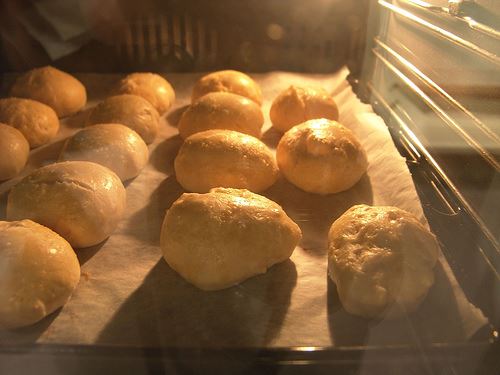
"Medias noches"
Another Epónimo: “Sandwich”: it comes from the English man, named John Montagu, IV Earl of Sandwich, who, in the XVIII Century, liked to play cards, but he did not want to stop the game; then, he asked for a fast food, based in something of meat or vegetable, among two slices of bread.So, the sandwich was born.Here, in Spain, that name entered, in the Royal Academy of the Spanish Language, in 1927.
Other word: “Pionono”: It is a sweet, typical cake from Santa Fé (Granada) (South-east of Spain).Its name comes from the travel made by the Pope Pio Nono (Pio IX = Nine) to that village.

A cake "Pionono".
Another special word: “Tertulia” and “Tertuliano”.Both words come from a sir named Quinto Septimio Florente Tertuliano, who lived in the First Century After Christ.He was a Father in the Church and also a writer.Surely he liked talking some long speeches; therefore, today is named “tertuliano” a person who talks and listen to another persons in a meeting.
The word: “Cotilla”.It comes from a woman, who lived in Madrid and she was named “La tia Cotilla”; she lived during the reign of Ferdinand VII and she was engaged to denounce anyone contrary to the absolutist regime.After that, we all know that “Cotilla” is a person who talks or gossips about someone.
In Spain we also use the word: “Boicot”.It comes from the Irish Captain Charles Boycott.
Another word: Mausoleo.It comes from the King Mausolo, who asked to build a special tom for his wife.That tomb was decorated by several sculptors from Halicarnaso (today: Turkey), in 350 Before Christ.
Other expression so used in Spain: “Estar en babia” (“To be in babia”).Babia is a nice village, in the province of León (North-west of Spain).Babia is a very tranquil place, where the different Kings liked to go in order to forget their problems.Then, when someone in the Court of one King asked for him, someone answered: “The King is in Babia…….”.So, today, when someone is vague, we say: “He –or she—is in Babia….”.
Surely you know another words; if you know some words, please tell me them.
Till soon, kind regards,
Luis.
Sponsored by Costaluz Lawyers.
Please click down here:
.jpg)
 0
Like
Published at 11:50 PM Comments (0)
0
Like
Published at 11:50 PM Comments (0)
Justice, family and child, in Spain
Friday, March 15, 2013
Justice, family and child are very different concepts, which over time have intertwined to create a maze difficult to understand.
To talk about this trouble, the Doctor of Law, María de la Válgoma has written a book entitled "Parents without rights, children without duties". In it, María says, among other things, that in past, Law was designed for adults. In fact, --she says--, she was surprised, when she investigated and found that children never had rights, before 1989, when was celebrated the Child Rights Convention, adopted by all countries of the world except Somalia and the United States.
Maria also says, in her book, that she is not get along with the Convention, where it was declared that is child everybody less than 18 years old; but María thinks that it is not the same a child two years old than a boy 17 years old. For example, she says that we can not think of freedom of expression for a child 2 years old; but a boy or a girl 16 or 17 years old has the right of freedom of expression.
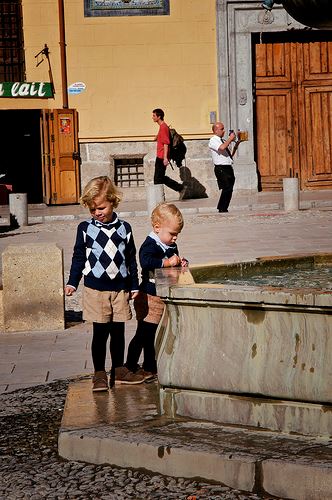
"Niños en Fuente", by Lombino, at flickr.com
María also says that it is a pity but, in the last years have increased the demands from parents against children. And she says that the principle of authority is missing; but children need authority.
Children may have rights but also has to accept some duties.
Till soon, kind regards,
Luis.
Sponsored by Costaluz Lawyers.
Please click down here:
.jpg)
 0
Like
Published at 1:47 AM Comments (0)
0
Like
Published at 1:47 AM Comments (0)
Prevention and treatment of Migraine in Spain
Thursday, March 7, 2013
The 90 per cent of Migraines can be treated and prevented with the administration of an enzyme called diAmine Oxidase (DAO), as demonstrated from a study by the Spanish Society of Deficit DAO and Capio General Hospital of Catalunya.
The study, which was brought under the “Infarma” Pharmaceutical Congress, held in Barcelona, is the first in the world to show that the administration of the DAO enzyme reduces migraines, as it was explained to EFE Agency by the lead researcher of this work, Joan Izquierdo Casas.
Migraine, which causes severe pain in one side of the head as well as visual and auditory discomfort, affecting 12 per cent of the population and 90 per cent of cases is that patients have a deficiency of the enzyme DAO.
By the way of visual discomfort, it is important to know that the "aura" occurs in one of every four patients with migraine; it lasts 20 to 60 minutes. When it disappears, there is a gap under an hour without symptoms and then begins the pain that corresponds to the next phase.
The most characteristic symptoms are the visuals, which can be very diverse, the most typical is to manifest as a scintillating scotoma consisting of a blind area of the visual field accompanied by a series of mobile light flashes.
_1.jpg)
Scotoma in the middle of the visual field, trying to replicate the sensation experienced during the aura phase.
This enzyme (DAO) is responsible for degrading a molecule named “Histamine”, found in many foods, primarily those derived from milk and citrus fruits, and that is subsequently removed in the urine.
People with DAO deficit can not eliminate histamine, with which it passes to the blood and it is accumulated in the plasma, causing adverse effects such as gastrointestinal disorders and migraine.
Therefore, the treatment would ingest before meals a capsule DAO enzyme, "that creates no adverse effects or because addiction is a functional food, a drug not unlike analgesics", said Izquierdo.
The neurologist has insisted that patients with migraine and DAO deficit should also change their diet and avoid foods with more histamine. So, avoid processed foods, such as meats, dairy products, citrus fruits and alcoholic beverages as these, and contain much histamine, inhibit the enzyme DAO.
"I always sensed that there was a relationship among the consumption of certain foods and migraine," said Izquierdo; but so far had not been scientifically proven and the relationship is questioned by the Spanish Society of Neurology.
According Izquierdo, who belongs to this scientific society, the study presented today demonstrates scientifically that migraine patients improve if given the enzyme DAO.
The study looked for a year and a half a hundred cases of severe chronic migraine patients, who had between 9 and 14 episodes of pain per month, of which 81% were women and 19% of men in a proportion similar to that between the patients of this disease.
The average age of patients who participated in the research is 41 years old and have been chosen according to the diagnostic criteria of the International Headache Society.
The study was double-blind, that is, neither the patients nor the doctors knew which group was administered the enzyme and which group was given placebo.
Moreover, the neurologist Izquierdo stressed that migraine is not inherited, but what is transmitted genetically is the deficit DAO, is that in most cases just triggering a migraine, but not always.
Thus, migraine is related to 90 per cent of patients with this enzyme deficiency, while in other cases still unknown what causes it.
I hope that you think this new is interesting as I did.
Kind regards,
Luis.
Please click down here:
.jpg)
 0
Like
Published at 12:55 AM Comments (0)
0
Like
Published at 12:55 AM Comments (0)
Motu proprio, in Spain.
Monday, March 4, 2013
Due to the recent resignation of the Pope Benedict XVI, the last saturday, I listened on the radio a program where a journalist talked about the latin expression "Motu proprio." Then I thought it would be interesting to talk to you about this.
A Motu proprio is a document, of the Catholic Church, issued by Pope on his own initiative and authority. It usually refers to short documents, affecting to some specific issues.
It is used as an expression to indicate that something is done spontaneously, without answering request.It is often used incorrectly as Motu propio, with only an “r”, or preceded by a preposition (de motu proprio or por motu proprio).
Regardless of its primary sense as "outcome document" of the Pope, is very frequently used in Spanish (in conversations, lectures, legal terms, conferences, etc). Therefore, it is very often hear the "de motu proprio" -- or erroneously "propio" = “own” --, ignoring the Latin meaning and construction that should never be overlooked.
The redundancy implies that "de" (“of”), accompanying "motu" -- which already has included in "motus" = movement -- forced to say "propio" (“own”), as indicative of a matter itself, although actually the "proprius "(used "proprio"), which is meant to “pro prius motus” (for first motive, first right, first impulse, for the first reaction ....) will issue "motu proprio" as being the first thing you think of.
I hope I have explained well the expression to you.
Till soon, kind regards,
Luis.
Sponsored by Costaluz Lawyers.
Please click down here:
.jpg)
 0
Like
Published at 1:29 PM Comments (1)
0
Like
Published at 1:29 PM Comments (1)
Spam post or Abuse? Please let us know
|
|